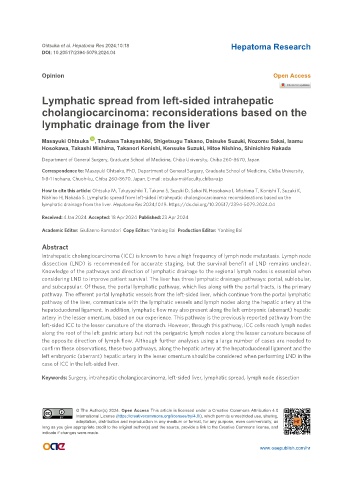Page 205 - Read Online
P. 205
Ohtsuka et al. Hepatoma Res 2024;10:18 Hepatoma Research
DOI: 10.20517/2394-5079.2024.04
Opinion Open Access
Lymphatic spread from left-sided intrahepatic
cholangiocarcinoma: reconsiderations based on the
lymphatic drainage from the liver
Masayuki Ohtsuka , Tsukasa Takayashiki, Shigetsugu Takano, Daisuke Suzuki, Nozomu Sakai, Isamu
Hosokawa, Takashi Mishima, Takanori Konishi, Kensuke Suzuki, Hitoe Nishino, Shinichiro Nakada
Department of General Surgery, Graduate School of Medicine, Chiba University, Chiba 260-8670, Japan.
Correspondence to: Masayuki Ohtsuka, PhD, Department of General Surgery, Graduate School of Medicine, Chiba University,
1-8-1 Inohana, Chuoh-ku, Chiba 260-8670, Japan. E-mail: otsuka-m@faculty.chiba-u.jp
How to cite this article: Ohtsuka M, Takayashiki T, Takano S, Suzuki D, Sakai N, Hosokawa I, Mishima T, Konishi T, Suzuki K,
Nishino H, Nakada S. Lymphatic spread from left-sided intrahepatic cholangiocarcinoma: reconsiderations based on the
lymphatic drainage from the liver. Hepatoma Res 2024;10:19. https://dx.doi.org/10.20517/2394-5079.2024.04
Received: 4 Jan 2024 Accepted: 18 Apr 2024 Published: 23 Apr 2024
Academic Editor: Giulianno Ramadori Copy Editor: Yanbing Bai Production Editor: Yanbing Bai
Abstract
Intrahepatic cholangiocarcinoma (ICC) is known to have a high frequency of lymph node metastasis. Lymph node
dissection (LND) is recommended for accurate staging, but the survival benefit of LND remains unclear.
Knowledge of the pathways and direction of lymphatic drainage to the regional lymph nodes is essential when
considering LND to improve patient survival. The liver has three lymphatic drainage pathways: portal, sublobular,
and subcapsular. Of these, the portal lymphatic pathway, which lies along with the portal tracts, is the primary
pathway. The efferent portal lymphatic vessels from the left-sided liver, which continue from the portal lymphatic
pathway of the liver, communicate with the lymphatic vessels and lymph nodes along the hepatic artery at the
hepatoduodenal ligament. In addition, lymphatic flow may also present along the left embryonic (aberrant) hepatic
artery in the lesser omentum, based on our experience. This pathway is the previously reported pathway from the
left-sided ICC to the lesser curvature of the stomach. However, through this pathway, ICC cells reach lymph nodes
along the root of the left gastric artery but not the perigastric lymph nodes along the lesser curvature because of
the opposite direction of lymph flow. Although further analyses using a large number of cases are needed to
confirm these observations, these two pathways, along the hepatic artery at the hepatoduodenal ligament and the
left embryonic (aberrant) hepatic artery in the lesser omentum should be considered when performing LND in the
case of ICC in the left-sided liver.
Keywords: Surgery, intrahepatic cholangiocarcinoma, left-sided liver, lymphatic spread, lymph node dissection
© The Author(s) 2024. Open Access This article is licensed under a Creative Commons Attribution 4.0
International License (https://creativecommons.org/licenses/by/4.0/), which permits unrestricted use, sharing,
adaptation, distribution and reproduction in any medium or format, for any purpose, even commercially, as
long as you give appropriate credit to the original author(s) and the source, provide a link to the Creative Commons license, and
indicate if changes were made.
www.oaepublish.com/hr

